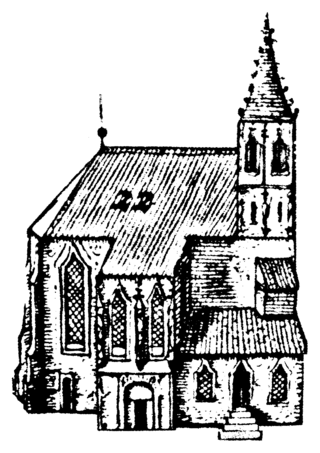
Vienna is the capital, largest city, and one of nine provinces of Austria. Vienna is Austria's most populous city and its primate city, with about two million inhabitants, and its cultural, economic, and political center. It is the sixth-largest city proper by population in the European Union and the largest of all cities on the Danube river.

The Innere Stadt is the 1st municipal district of Vienna located in the center of the Austrian capital. The Innere Stadt is the old town of Vienna. Until the city boundaries were expanded in 1850, the Innere Stadt was congruent with the city of Vienna. Traditionally it was divided into four quarters, which were designated after important town gates: Stubenviertel (northeast), Kärntner Viertel (southeast), Widmerviertel (southwest), Schottenviertel (northwest).

The Vergilius Chapel is an underground crypt next to the Stephansdom in Vienna. It is rectangular in form, with six niches. Today, it lies approximately 12 meters beneath the Stephansplatz.

The Stephansplatz is a square at the geographical centre of Vienna, Austria. It is named after its most prominent building, the Stephansdom, Vienna's cathedral and one of the tallest churches in the world. Before the 20th century, a row of houses separated Stephansplatz from Stock-im-Eisen-Platz, but since their destruction, the name Stephansplatz started to be used for the wider area covering both. To the west and south, respectively, run the exclusive shopping streets Graben and Kärntner Straße. Opposite the Stephansdom is the Haas-Haus, a piece of striking modern architecture by Hans Hollein. Although public opinion was originally skeptical about the combination of the mediaeval cathedral and the glass and steel building, it is now considered an example of how old and new architecture can mix harmoniously .
Microbacterium dextranolyticum is a bacterium of the family Microbacteriaceae.
Microbacterium aurum is a bacterium of the family Microbacteriaceae.
Microbacterium agarici is a Gram-positive and rod-shaped bacterium from the genus Microbacterium which has been isolated from the mushroom Agaricus blazei in Taiwan.
Microbacterium laevaniformans is a bacterium from the genus Microbacterium.
Microbacterium barkeri is a bacterium from the genus Microbacterium which has been isolated from domestic sewage and from smear from a cheeses. Microbacterium barkeri has the ability to degrade polyvinyl alcohol.
Microbacterium chocolatum is a bacterium from the genus Microbacterium.
Microbacterium foliorum is a bacterium from the genus Microbacterium which has been isolated from the phyllosphere of grasses in Germany.

Microbacterium gubbeenense is a Gram-positive, facultatively anaerobic, non-spore-forming and non-motile bacterium from the genus Microbacterium which has been isolated from the surface of a smear-ripened cheese in Ireland.
Microbacterium kitamiense is a heterotrophic, strictly aerobic, mesophilic and non-motile bacterium from the genus Microbacterium which has been isolated from waste water from a sugar-beet factory in Kitami in Japan. Microbacterium kitamiense produces polysaccharide. Microbacterium kitamiense has a high GC-content.
Microbacterium esteraromaticum is a rod shaped, gram positive species of bacteria under genus Microbacterium. Its G+C content of DNA is 69.3 to 69.7 mol%. It has other name, that is Flavobacterium esteraromaticum. In a culture of 30 degree Celsius it grows best.
Promicromonospora aerolata is a bacterium from the genus Promicromonospora which has been isolated from air from the Vergilius Chapel in Vienna, Austria.
Microbacterium oleivorans is a Gram-positive and crude-oil-degrading bacterium from the genus Microbacterium which has been isolated from an oil storage cavern in Germany.
Promicromonospora vindobonensis is a bacterium from the genus Promicromonospora which has been isolated from air from the Virgilkapelle in Vienna, Austria.
Microbacterium paraoxydans is a Gram-positive bacterium from the genus Microbacterium which was first isolated from the fish Nile tilapia in Mexico. This bacterium can cause disease in fish. Microbacterium paraoxydans metabolize (RS)-mandelonitrile to (R)-(-)mandelic acid. Microbacterium paraoxydans is a plant growth-promoting bacteria.
Microbacterium terrae is a bacterium from the genus of Microbacterium which has been isolated from soil in Osaka on Japan.
Cannabis in Yemen is illegal. Cannabis is less common in Yemen than khat.




